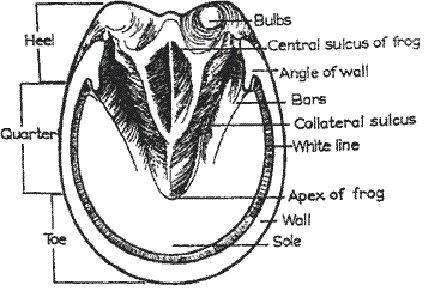Understanding the Horse’s Hoof
As a farrier trimming horses’ hooves, the sole and frog are important to understand because it allows the hoof to work correctly by shedding dirt and manure. Also, allowing access to the whole frog and heels of the hoof to place Outlaw Thrush Stuff treatment in hard-to-reach infected sites, not just treating the manure packed in the hoof.

Understanding Benefits of a Clean Hoof
Now that you’ve removed the visible dirt and debris from your horse’s hooves, you’ll want to clean the affected area and treat it with Outlaw Thrush Stuff. Others suggest treating thrush with bleach. However, it’s worth noting that harsh chemicals can dry out your horse’s hooves, which may make them prone to further injuries and afflictions. Outlaw Thrush Stuff is not harmful to the hoof tissues. Thrush Stuff is formulated to penetrate the hoof’s nooks and crannies of the necrotic tissue, not sit on the surface as some powders do. It is an antiseptic and astringent to clean thrush from the affected area.
Maintenance of the Hoof
After trimming the affected area of the frog, you’re ready to clean the hoof. Cleaning the hoof should become a daily part of your horse maintenance going forward, as it will help prevent injury and reduce the chances of thrush returning in the future. Be careful, though, as the horse may be in considerable pain, and cleaning out its affected hoof may frighten or anger your horse.
1) Use a hoof pick to pick out any larger debris from the affected area.
2) Now, you can pack the affected area with cotton.
3) Then apply Outlaw Thrush Stuff by squirting it into the sulcus of the hoof, which are the V-like indentations that make up the “valley” of the hoof’s frog.
Give Your Horse Some Dry Footing
Give your horse some dry footing. Wet and dirty footing is one of the leading causes of hoof thrush in horses. If you keep your horse outside in an enclosure and the ground is constantly wet, let your horse come into a barn or stable stall occasionally to allow the hooves to dry out. Keeping the stable and paddocks clean and dry is best.
- Muck out manure from the stalls and clean or dig out the urine spots daily.
- Spread gravel or shavings in the paddocks or on the stable floor so your horse can stand on dry footing, even when the ground underneath is wet.
- Exercising your horse regularly along with the functional anatomy of the hoof.
Regular exercise can help prevent thrush in horses. That’s because movement expands and contracts the hooves, which can push debris out of the grooves in the hooves.
Even if you can’t turn out your horse in an enclosure, hand-walking or riding on dry ground can significantly reduce the chances of thrush developing.
What causes thrush in horses? and how to treat
Thrush in horses and treatment. Thrush is an infection of the central and lateral V of the frog of the horse’s foot, most often involving bacterial infection, occasionally fungal infection. One species of bacterium (Fusobacterium necrophorum) is particularly aggressive, invading and destroying the frog, sometimes exposing the deeper sensitive tissues. Long heel conformation encourages the development of a deep narrow V of the frog that is more prone to the development of thrush if environmental conditions are right.
How is thrush in horses diagnosed?
Thrush produces a foul-smelling black discharge in the affected V of the frog. There is pain when applying pressure to the area. The hind feet are more often affected than the front feet, and occasionally, the infection may result in a general swelling of the distal (lower) limb.
